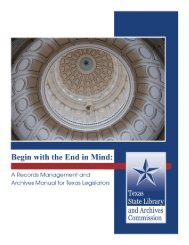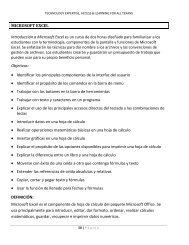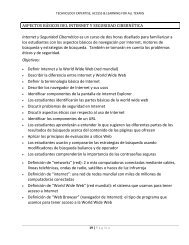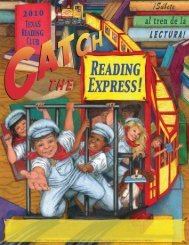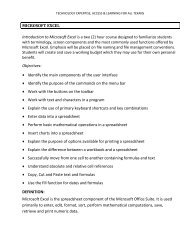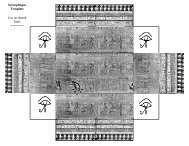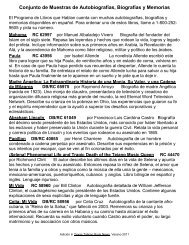How did the Growth of Railroads Impact Population Growth?
How did the Growth of Railroads Impact Population Growth?
How did the Growth of Railroads Impact Population Growth?
You also want an ePaper? Increase the reach of your titles
YUMPU automatically turns print PDFs into web optimized ePapers that Google loves.
Instructional Recipe<br />
<strong>How</strong> <strong>did</strong> <strong>the</strong> <strong>Growth</strong> <strong>of</strong> <strong>Railroads</strong> <strong>Impact</strong><br />
<strong>Population</strong> <strong>Growth</strong>?<br />
Grade 7, Texas History<br />
Step 1 – Ask<br />
Objectives:<br />
Students will identify <strong>the</strong> effects <strong>of</strong> <strong>the</strong> growth <strong>of</strong> railroads on<br />
immigration. Students will analyze <strong>the</strong> political, economic, and<br />
social impact <strong>of</strong> immigration on Texas.<br />
Introduction:<br />
“Map <strong>of</strong> <strong>the</strong> Southwest”:<br />
http://www.tsl.state.tx.us/exhibits/railroad/fight/map1592-display.html<br />
(Click on <strong>the</strong> link to view an enlarged version <strong>of</strong> <strong>the</strong> map.)<br />
Ask:<br />
<strong>How</strong> do you think <strong>the</strong> railroad routes affect <strong>the</strong> communities<br />
and people <strong>of</strong> Texas in <strong>the</strong> 1870s and 1880s?<br />
Using <strong>the</strong> statistics provided on <strong>the</strong> map, what happened to <strong>the</strong><br />
population between 1870 and 1880?<br />
Do you think <strong>the</strong>se changes affected Texas politics, <strong>the</strong><br />
economy, or society? Why or why not?<br />
Vocabulary:<br />
commerce – trade; business<br />
immigration – movement <strong>of</strong> people into an area to settle<br />
land grant – land that is set aside for a specific reason, in this<br />
case for internal improvements such as transportation,<br />
developing new industries, or agricultural production. The<br />
goals <strong>of</strong> internal improvement were to promote population<br />
growth, increase land values, and expand markets for Texas<br />
goods.<br />
Online research and information resources<br />
available through a partnership between<br />
<strong>the</strong> Texas State Library and Archives<br />
Commission, <strong>the</strong> Texas Education Agency<br />
and Education Service Center, Region 20<br />
http://web.esc20.net/k12databases<br />
TEKS:<br />
(7.3 C) identify significant individuals, events,<br />
and issues from Reconstruction through <strong>the</strong><br />
beginning <strong>of</strong> <strong>the</strong> 20 th century, including <strong>the</strong><br />
effects <strong>of</strong> <strong>the</strong> growth <strong>of</strong> railroads and <strong>the</strong><br />
contributions <strong>of</strong> James Hogg.<br />
(7.11 B) analyze how immigration and migration<br />
to Texas in <strong>the</strong> 19th, 20th, and 21st centuries<br />
have influenced Texas;<br />
(7.21 A) differentiate between, locate, and use<br />
primary and secondary sources such as<br />
computer s<strong>of</strong>tware, databases, media and news<br />
services, biographies, interviews, and artifacts to<br />
acquire information about Texas.<br />
(7.21B) analyze information by sequencing,<br />
categorizing, identifying cause-and-effect<br />
relationships, comparing, contrasting, finding <strong>the</strong><br />
main idea, summarizing, making generalizations<br />
and predictions, and drawing inferences and<br />
conclusions.<br />
(7.21C) organize and interpret information from<br />
outlines, reports, databases, and visuals<br />
including graphs, charts, timelines, and maps.<br />
(7.21D) identify points <strong>of</strong> view from <strong>the</strong> historical<br />
context surrounding an event and <strong>the</strong> frame <strong>of</strong><br />
reference that influenced <strong>the</strong> participants.<br />
(7.21E) support a point <strong>of</strong> view on a social<br />
studies issue or event.<br />
Technology Application TEKS:<br />
(6A) Determine and employ methods to<br />
evaluate <strong>the</strong> electronic information for<br />
accuracy and validity<br />
(6B) Resolve information conflicts and<br />
validate information through accessing,<br />
researching, and comparing data<br />
(6C) Demonstrate <strong>the</strong> ability to identify <strong>the</strong><br />
source, location, media type, relevancy, and<br />
content validity <strong>of</strong> available information.<br />
(7A) Plan, create, and edit documents created<br />
with a word processor using readable fonts,<br />
alignment, page setup, tabs, andruler settings<br />
(7E) Create a document using desktop<br />
publishing techniques including, but not<br />
limited to, <strong>the</strong> creation <strong>of</strong> multi-column<br />
or multi-section documents with a<br />
variety <strong>of</strong> text-wrapped frame formats.<br />
(10A) Use productivity tools to create<br />
effective document files for defined<br />
audiences such as slide shows, posters,<br />
multimedia presentations, newsletters,<br />
brochures, or reports.<br />
(10D) Demonstrate appropriate use <strong>of</strong> fonts,<br />
styles, and sizes, as well as effective use <strong>of</strong><br />
graphics and page design to effectively<br />
communicate<br />
Created by Ravae Villafranca Shaeffer, Education Service Center, Region 20 1
Step 2 – Investigate<br />
Texas State Library and Archives Resources:<br />
Map <strong>of</strong> <strong>the</strong> Southwest / 1881. Texas State Archives Map Number 1592. Texas<br />
State Archives Map Collection, Texas State Library and Archives Commission.<br />
http://www.tsl.state.tx.us/exhibits/railroad/fight/map1592-display.html<br />
“The Farmers vs. <strong>the</strong> <strong>Railroads</strong>”:<br />
http://www.tsl.state.tx.us/exhibits/railroad/fight/page2.html<br />
“Texas <strong>Railroads</strong> after <strong>the</strong> Civil War”:<br />
http://www.tsl.state.tx.us/exhibits/railroad/beginnings/page3.html<br />
Additional Websites:<br />
“Land Grants for Internal Improvements.”<br />
http://tshaonline.org/handbook/online/articles/mnl04<br />
“Missouri-Kansas-Texas Railroad”:<br />
http://www.tshaonline.org/handbook/online/articles/eqm08<br />
“<strong>Railroads</strong>”: http://tshaonline.org/handbook/online/articles/eqr01<br />
Use <strong>the</strong> above resources to record information on <strong>the</strong> concept map on <strong>the</strong> next page.<br />
Think about <strong>the</strong> following when using <strong>the</strong> primary sources above:<br />
What message is <strong>the</strong> source trying to communicate?<br />
Who is <strong>the</strong> intended audience for this source?<br />
What parts <strong>of</strong> <strong>the</strong> source informs you about <strong>the</strong> topic <strong>of</strong> <strong>the</strong> lesson?<br />
Which sources support or refute your original thoughts about <strong>the</strong> topic?<br />
Created by Ravae Villafranca Shaeffer, Education Service Center, Region 20 2
Step 3 – Create<br />
Students can work individually or with partners to create a concept map that<br />
organizes <strong>the</strong> information <strong>the</strong>y learned about Texas. Here are some suggested<br />
topics that could be included:<br />
Technology Link – Students may use graphic organizer s<strong>of</strong>tware such as<br />
Inspiration, draw a table in a word processor, or create a spreadsheet using<br />
Micros<strong>of</strong>t Excel to map out <strong>the</strong>ir ideas.<br />
Allow students to share <strong>the</strong>ir information with ano<strong>the</strong>r group or as a whole<br />
class.<br />
<strong>Population</strong><br />
growth<br />
Political<br />
changes<br />
(regulation, etc.)<br />
<strong>Impact</strong> <strong>of</strong><br />
<strong>Railroads</strong><br />
1870s to<br />
1880s<br />
Economic<br />
changes<br />
(commerce, trade,<br />
etc.)<br />
Immigration<br />
Created by Ravae Villafranca Shaeffer, Education Service Center, Region 20 3
Step 4 – Discuss<br />
Students may choose one <strong>of</strong> <strong>the</strong> following projects to complete:<br />
Pretend you are <strong>the</strong> mayor <strong>of</strong> a Texas town in <strong>the</strong> 1880s where <strong>the</strong> railroad<br />
has been built. Design and present a brochure to <strong>the</strong> people <strong>of</strong> Texas to<br />
inform <strong>the</strong>m <strong>of</strong> <strong>the</strong> political, social, and economic changes that have impacted<br />
<strong>the</strong> town’s economy, population (including immigration to <strong>the</strong> area), and<br />
industries.<br />
A railroad has been built near your town. You were asked to be a member on<br />
a committee that will work to promote growth in your area. Design and<br />
present a brochure advertising <strong>the</strong> benefits <strong>of</strong> your town (and <strong>the</strong><br />
surrounding region) in order to recruit new immigrants to your part <strong>of</strong><br />
Texas. Be sure to include maps and images that would encourage people to<br />
move to your area. Be sure to highlight <strong>the</strong> political, social, and economic<br />
changes that have encouraged growth in <strong>the</strong> region’s economy, population,<br />
and industries.<br />
Technology Link - Students can use Micros<strong>of</strong>t Word or Publisher to develop <strong>the</strong>ir<br />
products. Use <strong>the</strong> EBSCO image collection to help you find images <strong>of</strong> Texas.<br />
Step 5 – Reflect<br />
Allow students to present <strong>the</strong>ir projects to <strong>the</strong> rest <strong>of</strong> <strong>the</strong> class. Use <strong>the</strong><br />
following suggested rubric to assess <strong>the</strong> students’ work. Make sure that <strong>the</strong><br />
students are familiar with <strong>the</strong> rubric before <strong>the</strong>y begin creating <strong>the</strong>ir project.<br />
They should refer to <strong>the</strong> rubric repeatedly to monitor <strong>the</strong>ir progress in creating<br />
<strong>the</strong>ir project.<br />
Technology Link: You can also create your own rubric with your students at<br />
http://rubistar.4teachers.org/index.php.<br />
Created by Ravae Villafranca Shaeffer, Education Service Center, Region 20 4
Teacher Name:___________________________________________________<br />
Student(s) Name(s): ___________________________________________________<br />
Design A Brochure Rubric : <strong>Railroads</strong> Change <strong>the</strong> Town<br />
CATEGORY 4 3 2 1<br />
Knowledge<br />
Gained<br />
Content -<br />
Accuracy<br />
All students in<br />
<strong>the</strong> group can<br />
accurately<br />
answer all<br />
questions related<br />
to facts in <strong>the</strong><br />
brochure and to<br />
technical<br />
processes used to<br />
create <strong>the</strong><br />
brochure.<br />
All facts in <strong>the</strong><br />
brochure are<br />
accurate.<br />
All students in<br />
<strong>the</strong> group can<br />
accurately<br />
answer most<br />
questions related<br />
to facts in <strong>the</strong><br />
brochure and to<br />
technical<br />
processes used to<br />
create <strong>the</strong><br />
brochure.<br />
99-90% <strong>of</strong> <strong>the</strong><br />
facts in <strong>the</strong><br />
brochure are<br />
accurate.<br />
Most students in<br />
<strong>the</strong> group can<br />
accurately<br />
answer most<br />
questions related<br />
to facts in <strong>the</strong><br />
brochure and to<br />
technical<br />
processes used to<br />
create <strong>the</strong><br />
brochure.<br />
89-80% <strong>of</strong> <strong>the</strong><br />
facts in <strong>the</strong><br />
brochure are<br />
accurate.<br />
Several students<br />
in <strong>the</strong> group<br />
appear to have<br />
little knowledge<br />
about <strong>the</strong> facts or<br />
technical<br />
processes used in<br />
<strong>the</strong> brochure.<br />
Fewer than 80%<br />
<strong>of</strong> <strong>the</strong> facts in <strong>the</strong><br />
brochure are<br />
accurate.<br />
Graphics/Pictures Graphics go well<br />
with <strong>the</strong> text and<br />
<strong>the</strong>re is a good<br />
mix <strong>of</strong> text and<br />
graphics.<br />
Attractiveness &<br />
Organization<br />
The brochure has<br />
exceptionally<br />
attractive<br />
formatting and<br />
well-organized<br />
information.<br />
Graphics go well<br />
with <strong>the</strong> text, but<br />
<strong>the</strong>re are so<br />
many that <strong>the</strong>y<br />
distract from <strong>the</strong><br />
text.<br />
The brochure has<br />
attractive<br />
formatting and<br />
well-organized<br />
information.<br />
Graphics go well<br />
with <strong>the</strong> text, but<br />
<strong>the</strong>re are too few<br />
and <strong>the</strong> brochure<br />
seems "tex<strong>the</strong>avy".<br />
The brochure has<br />
well-organized<br />
information.<br />
Graphics do not<br />
go with <strong>the</strong><br />
accompanying<br />
text or appear to<br />
be randomly<br />
chosen.<br />
The brochure's<br />
formatting and<br />
organization <strong>of</strong><br />
material are<br />
confusing to <strong>the</strong><br />
reader.<br />
Created by Ravae Villafranca Shaeffer, Education Service Center, Region 20 5
Teacher Name:___________________________________________________<br />
Student(s) Name(s): ___________________________________________________<br />
Oral Presentation Rubric (to Present Brochure):<br />
<strong>Railroads</strong> Change <strong>the</strong> Town<br />
CATEGORY 4 3 2 1<br />
Content<br />
Shows a full<br />
understanding <strong>of</strong><br />
<strong>the</strong> topic.<br />
Shows a good<br />
understanding <strong>of</strong><br />
<strong>the</strong> topic.<br />
Shows a good<br />
understanding <strong>of</strong><br />
parts <strong>of</strong> <strong>the</strong> topic.<br />
Does not seem<br />
to understand<br />
<strong>the</strong> topic very<br />
well.<br />
Comprehension<br />
Stays on Topic<br />
Student is able to<br />
accurately answer<br />
almost all<br />
questions posed<br />
by classmates<br />
about <strong>the</strong> topic.<br />
Stays on topic all<br />
(100%) <strong>of</strong> <strong>the</strong><br />
time.<br />
Student is able to<br />
accurately answer<br />
most questions<br />
posed by<br />
classmates about<br />
<strong>the</strong> topic.<br />
Stays on topic<br />
most (99-90%) <strong>of</strong><br />
<strong>the</strong> time.<br />
Student is able to<br />
accurately answer<br />
a few questions<br />
posed by<br />
classmates about<br />
<strong>the</strong> topic.<br />
Stays on topic<br />
some (89%-75%)<br />
<strong>of</strong> <strong>the</strong> time.<br />
Student is<br />
unable to<br />
accurately<br />
answer<br />
questions posed<br />
by classmates<br />
about <strong>the</strong> topic.<br />
It was hard to<br />
tell what <strong>the</strong><br />
topic was.<br />
Preparedness<br />
Collaboration<br />
with Peers<br />
Student is<br />
completely<br />
prepared and has<br />
obviously<br />
rehearsed.<br />
Almost always<br />
listens to, shares<br />
with, and<br />
supports <strong>the</strong><br />
efforts <strong>of</strong> o<strong>the</strong>rs<br />
in <strong>the</strong> group.<br />
Tries to keep<br />
people working<br />
well toge<strong>the</strong>r.<br />
Student seems<br />
pretty prepared<br />
but might have<br />
needed a couple<br />
more rehearsals.<br />
Usually listens to,<br />
shares with, and<br />
supports <strong>the</strong><br />
efforts <strong>of</strong> o<strong>the</strong>rs<br />
in <strong>the</strong> group.<br />
Does not cause<br />
"waves" in <strong>the</strong><br />
group.<br />
The student is<br />
somewhat<br />
prepared, but it is<br />
clear that<br />
rehearsal was<br />
lacking.<br />
Often listens to,<br />
shares with, and<br />
supports <strong>the</strong><br />
efforts <strong>of</strong> o<strong>the</strong>rs<br />
in <strong>the</strong> group but<br />
sometimes is not<br />
a good team<br />
member.<br />
Student does not<br />
seem at all<br />
prepared to<br />
present.<br />
Rarely listens to,<br />
shares with, and<br />
supports <strong>the</strong><br />
efforts <strong>of</strong> o<strong>the</strong>rs<br />
in <strong>the</strong> group.<br />
Often is not a<br />
good team<br />
member.<br />
Created by Ravae Villafranca Shaeffer, Education Service Center, Region 20 6


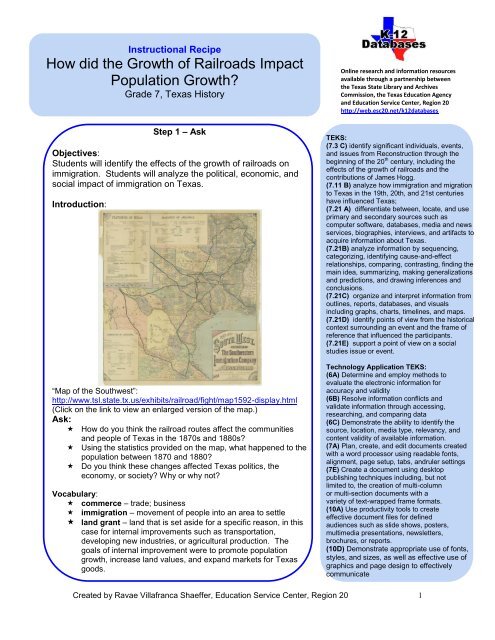
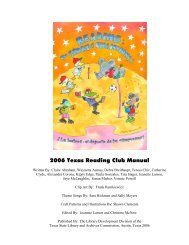
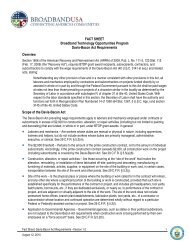
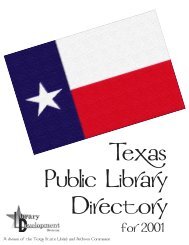
![Harry Potter [pdf]](https://img.yumpu.com/27329912/1/190x245/harry-potter-pdf.jpg?quality=85)
![Aplicaciones del Programa de Libros que Hablan [pdf] - Texas State ...](https://img.yumpu.com/27329907/1/190x245/aplicaciones-del-programa-de-libros-que-hablan-pdf-texas-state-.jpg?quality=85)


